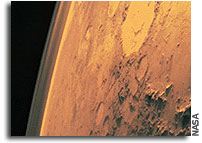Pioneering Space: The Next Steps on the Path to Mars

Over the past four years, NASA has been implementing the NASA Authorization Act of 2010, which was enacted on a broad bipartisan basis and reflects agreement between Congress and the Administration on the nation’s next steps in space. A new paper from our Human Exploration and Operations Mission Directorate (HEOMD) explains NASA’s roadmap to send astronauts to an asteroid by 2025 and Mars in the 2030s. You can read HEOMD’s “Pioneering Space” document at: http://go.nasa.gov/1mL91Il
This human exploration roadmap calls on NASA to facilitate commercial access to low-Earth orbit to sustain foundational scientific research on the International Space Station (ISS); develop and evolve the Space Launch System (SLS) heavy-lift rocket and Orion spacecraft to enable human exploration in deep space; and to develop new technologies for tomorrow’s missions, all leading the way on a path to Mars in the 2030s.
We’ve made great progress in all of these areas and continue to implement this exciting plan. Our stepping stone approach builds on our work living and working aboard the ISS to achieve scientific breakthroughs not possible here on Earth and serve as a springboard to NASA’s next great leap in human exploration. We’ll use the proving ground of cis-lunar space to demonstrate and mature various technologies and roadmap elements, and we will pursue the capture and redirect of an asteroid enabling astronauts to visit it and obtain samples. All this work will eventually enable astronaut missions to Mars.
Our pursuits are big – and the path to Mars is hard. Our work requires systematic and deliberate long range planning. Federal budgets can fluctuate, but our plan is strategic and sustainable. Developing and evolving our human exploration roadmap builds on our current capabilities as we move toward Earth independence on the path to Mars. All of our work is applicable across a wide range of missions and activities, and will further NASA’s contributions to society, yielding applications to improve life here on Earth.
Building on today’s investments in the ISS, the Commercial Crew Program, SLS and Orion, and Space Technology programs, as well as our robotic science endeavors around and on the surface of Mars, the United States is poised to lead the next wave of missions and partnerships to pioneer the space frontier. Simply put: we aim to expand human presence and exploration in the solar system and on the surface of Mars.
Our progress in implementing this exciting roadmap has just begun. At the end of this year we send the Orion spacecraft to space for the first time on Exploration Flight Test-1. Soon, we’ll contract for commercial crew services enabling us to once again launch astronauts from American soil by 2017. Next year, for the first time, we launch a crew for a one-year mission aboard the ISS. Our next science mission to Mars, MAVEN, will reach the Red Planet this September, to be followed by the InSight lander in 2016 and the Mars 2020 rover. Already, Curiosity’s work has taught us much more about the Martian surface and what environment astronauts will encounter there. Next week, our Space Technology Mission Directorate continues groundbreaking demonstrations that will further our nation’s capabilities in entry descent and landing. The directorate also is working on solar electric propulsion and many other innovations vital to taking humanity into deep space and on the path to Mars. There is tangible progress across NASA–on drawing boards, in manufacturing facilities, on launch pads and in space.
I hope you’ll take a moment to read HEOMD’s document. Together, we’re accomplishing big things in this new era of exploration.
Charlie B.
X









